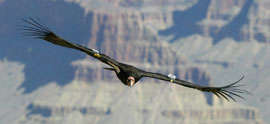Cronkite News has moved to a new home at cronkitenews.azpbs.org. Use this site to search archives from 2011 to May 2015. You can search the new site for current stories.
Supporters tout success of Arizona’s program to save condors from lead
PHOENIX – For the past five years, state officials have asked successful big-game hunters leaving the Kaibab National Forest whether they used lead bullets and, if so, whether they left behind gut piles.
Their goal: keeping California condors from ingesting lead, to which many of the endangered birds have been exposed since condors were reintroduced to northern Arizona in 1996.
The Arizona Game and Fish Department says 80 to 90 percent of hunters take part in the program, which offers free copper ammunition and educates those who plan to use lead ammunition about how to properly deal with animal remains.
Hunters who turn in gut piles on the way out – more than 140 did so last season – are eligible to win prizes. Those who didn’t are asked where the gut piles are so officials can remove them.
“We truly have had a successful program,” said Lynda Lambert, a Game and Fish spokeswoman. “To have so many hunters voluntarily participate is tremendous.”
Lead poisoning is the leading cause of death among Arizona’s population of California condors, according to Game and Fish.
In 1991, the U.S. Fish and Wildlife Service banned the use of lead shot for hunting waterfowl because the pellets poison birds that eat them off the bottoms of streams and lakes. Since 2008, California has required non-lead ammunition for hunting big game and coyotes in the California condor’s range.
The Sierra Club, Center for Biological Diversity and Grand Canyon Wildlands Council contend in a lawsuit filed in September that despite Arizona’s program lead bullets are still harming condors.
“We think the voluntary program is a good thing, but it doesn’t go nearly far enough and condors are still dying,” said Sandy Bahr, director of the Sierra Club’s Grand Canyon Chapter.
Removing lead from the system would protect not only condors but other wildlife and people too, Bahr said.
“This is not about hunting, or banning hunting, this merely has to do with what is used for hunting,” she said. “The world didn’t collapse when lead shot could no longer be used for waterfowl.”
Under the Game and Fish program, those who receive big-game tags to hunt in the condors’ range get a coupon for a free box of copper ammunition, which is more expensive than lead bullets.
Robert Hoskins, founder of the Arizona Hunting Club, said hunters have no problem taking part in the program to protect the environment. He said he’s used copper ammunition and couldn’t tell the difference.
“If they want people to use the copper bullets, just make them the same price as lead,” he said. “But don’t force us to do something.”
While they are endangered, California condors were reintroduced to Arizona under a provision of the Endangered Species Act that considers the population here not essential to the species’ survival.
Chris Parish, director of the condor program for the Peregrine Fund, an Idaho-based nonprofit that assists Game and Fish with the reintroduction effort, said lead is a problem that can be managed.
“With the help of hunters we can do better for hunters and do better for conservation of endangered species,” he said.








